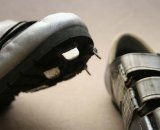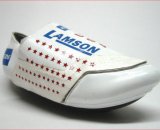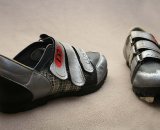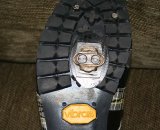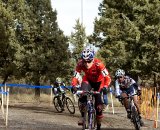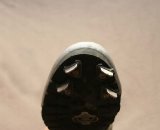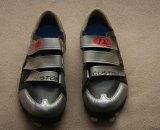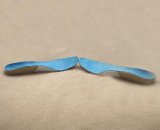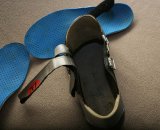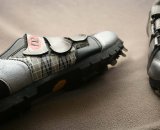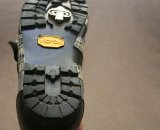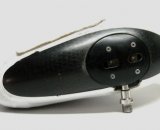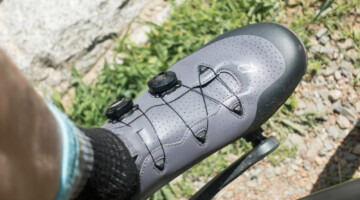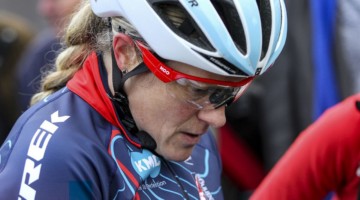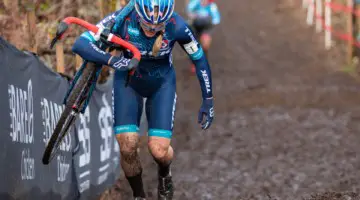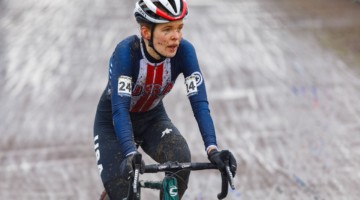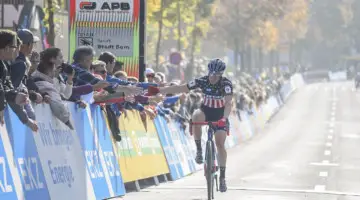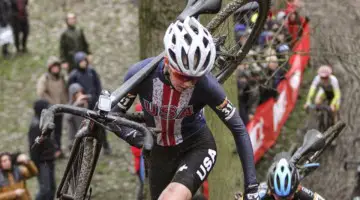Watch Katie Compton pushing the pace at the front of one of the upcoming World Cups and take a gander at her gear. She and her husband Mark are discerning customers, to say the least, and you’ll recognize some of cyclocross’ biggest name brands decking out Compton’s bike and body – until you get down to her feet. If you can freeze-frame her blur of a pedal stroke, you’ll see three Velcro straps with no ratcheting system anywhere, a red and black D2 logo across one of them and the word “Custom” across another.
The Background
D2 Shoes isn’t a Johnny come lately to the world of high-end cycling shoes, nor is this the company’s first foray into off-road footwear. In fact, owner Don Lamson made his first prototype carbon-soled model with three straps across the top of the foot and the carbon sole encasing an interior foam core back in 1986. “As far as I know, it was the first fully carbon sole, and I was using the foam core to make it lighter,” recounts Lamson. “Shimano was playing with a carbon plate around the cleat to stiffen up that area, but it wasn’t the entire sole.” That shoe featured what Lamson describes as a Lycra sock upper, and he sourced the carbon fiber from nearby in Denver, Colorado.
Lamson, who got his start by making orthotics and custom ski boots in the late 70s through mid-80s, quickly realized the applicability of individualized cycling shoes. “No one was making a bike shoe with orthotics, and I was doing a lot of custom alignment with fore-foot work for people,” says Lamson.
His next cycling shoe iteration was the “Doni” line, with pre-pregged carbon and fiberglass soles. These too had a foam core center to the sole, which Lamson says made them really light and stiff, with snap and a little bit of flex for comfort. The straps were Velcro then, and they still are now. While the material may have been cutting-edge technology in the 80s, despite other manufacturers since moving on to various boa, ratcheting or buckle apparatuses, Lamson has never found a worthy replacement for the simple self-adhering straps. “I never really liked buckles, they create hot spots and either apply too much pressure or not enough,” says Lamson. “Velcro wraps nicely around the foot, it’s better at holding the foot in place without the pressure. Also, if you hit a buckle and break it, you’re really screwed. Velcro pretty much doesn’t fail.”
D2’s niche has been cyclists with problem feet, or roadies looking for ultra-lightweight kicks. The process starts by ordering a fit kit, which arrives by mail, pressing your feet into foam to give impressions of each foot, then tracing them onto paper for another look at their shape. A phone call with Lamson will determine other fit preferences as well as riding styles, problem areas and whether to incorporate mesh for ventilation or solid material for protection. Have different-sized feet (as most of us do)? Not a problem.
Another customer who will instantly see the appeal of D2’s offerings is someone with a leg length discrepancy. Although there are easy fixes involving shims for road shoes, these shims can be ineffective for off-road use since they alter the interface between cleat and shoe – particularly with Crank Brothers pedals – and range from awkward to downright dangerous for cyclocrossers or mountain bikers who need to be able to run, or even walk, on the now-protruding cleats. By going custom, any discrepancy can be compensated for with extra material between the upper and the sole, keeping the cleat interface standardized. “The pedal needs to sit on the sole,” says Lamson. “If you just build up a cleat, the pedal’s not going to be stable. Eventually you can tear the cleat right out of the shoe.”
Custom vs. Heat Moldable
The obvious, and perhaps hard to ask, question for a custom shoe guy concerns the place for the variety of heat-moldable models on the market. Lamson didn’t bat an eye. “They’re better than nothing, but not custom. Consider the girth around the last: If you have a narrow foot, you still have too much material [after molding]. You can’t either add or take away material,” says Lamson. “Why bother if you can do it the right way?”
The Fang
Under the Lamson Design brand, Don began producing mountain bike shoes in 1991, and has had off-road offerings ever since. But his latest model, the Fang, is his first cyclocross-specific design. While some manufacturers may slap a “cyclocross” tag on a variation of an existing product to capitalize on a growing market sector, the Fang is a world apart from D2’s MTB predecessors. First off, it’s by no means light weight. Rather, the Fang is a purpose-built to provide a super-stiff interface between shoe and pedal, offer flex in the middle of the foot for running, keep the weather out and be durable under adverse conditions.
But the most notable features are on the underside – the full Vibram sole is more reminiscent of a hiking shoe than what you imagine underneath a top World Cup contender. And the toe spikes? They just look mean. Rather than the typical two round, screw-in spikes, Lamson chose four baseball cleats per shoe – and that’s where the Fang gets its name.
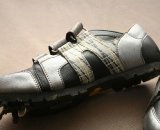
Both the sailcloth and the Velcro straps barely stretch - which means your pedals come up as soon as you foot does ©Josh Liberles
The other striking feature of the shoes comes from D2’s other models: the use of carbon- and kevlar-reinforced sail cloth along the sides. Not only does this add to the durability, but there’s also zero stretching going on. When you pull up on the shoes, the pedals are right there with them.
“There’s a special insole inside the shoe that the upper gets lasted to. The material is the normal fibrous material [used there in other D2 shoes] combined with polyethylene plastic in between, which stiffens it up but still flexes,” says Lamson.
A carbon shank runs from the cleat to the heel, so the shoe is stiff in the back but allows for give in the front. The shank is also narrower than the full width of the Vibram sole, which allows the shoe to better adapt to off-camber terrain.
According to Lamson, other big shoe manufacturers have a slab of plastic with a tread over it, and they therefore can’t fine-tune the performance. When building up a Fang, Lamson can select from nine different widths, and nine different corresponding soles. “With Sidis, for example, you might have several different widths available, but they’re all built on the same sole,” says Lamson.
Appeal for the Comptons
Both Katie and Mark Compton initially approached Don because they had various issues to address. “I had Don install a shim for my short left leg. It feels like I can apply power at the bottom of the pedal stroke for the first time,” says Mark. “I also have extremely sensitive feet and have one foot two sizes smaller than the other, so I can finally get the cleat sitting in the correct spot instead of constantly moving my [smaller] foot around inside the shoe to find the proper line up. Katie has the same issue, but she has one foot one size smaller than the other, and she has very bad bunions.”
“Don has a great deal of history in the sport and a huge wealth of experience and knowledge of cycling shoes and cleat placement,” says Mark. “Normally it takes Katie a week to 10 days to set up her cleat position. With the D2s, it takes less than 30 minutes. The setup is really easy since the cleat position is based off your actual feet dimensions. She received her Fang shoes two days before we left for [the Aigle World Cup]. Normally we wouldn’t run brand new shoes.” Katie Compton went on to put the shoes to good use, winning the season’s first World Cup by a comfortable 30 seconds.
My Experiences – the Review
As someone who has a 6mm discrepancy myself, I can vouch for Lamson’s assessment for add-on solutions. My road setup is an easy fix with shims, but I struggled to find a solution for cyclocross – and it’s what initially led me to try out the Fangs.
I’ve raced D2 shoes on the road for the past several seasons and have been pleased both by their comfort and performance, as well as with the company’s warranty and willingness to stand behind its products. If there are any issues with fit, D2 will make any necessary adjustments. And if you shred the shoes, Lamson will work with you to repair them if they’re salvageable. That brings up the main thing that sets D2 apart – it’s a small, accountable company with a wealth of experience making high-end products. On to the shoes…
Out of the box, the shoes are striking, and definitely attention getting; be prepared for them to spark conversations. There are tons of different color combinations, including optional use of D2’s signature checker boards, meaning your shoes will have a custom look too. I opted for a more subdued mix of silver and black, but the carbon- and Kevlar-enforced sailcloth stands out. And if anyone catches sight of your spikes, they’ll be intimidated.
On the bike, they felt great right away, similar to Compton’s first impressions. The cleat holes are positioned based on your foot measurements, so there’s no guesswork there, and the shoes felt like they were made for my feet – because they were. One surprising thing was that the stack height was slightly more than my previous Specialized and Diadora shoes – perhaps due to the Fangs’ custom orthotics – and I had to raise my saddle about 1mm to compensate for that. While that millimeter may be important for a super-fast time trialist, I wasn’t concerned about the negligible aerodynamic implications, but did pay a little extra attention on my first few remounts. I’ve learned the hard way that missing a landing by even 1mm can have catastrophic consequences.
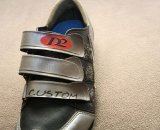
They look pretty darned good after a nasty season - the vegetable matter trapped in the Velcro is the primary giveaway ©Josh Liberles
I was able to put the shoes through two months of trench-warfare-style racing, with deep mud and rain the norm in the Northwest this season. The durability has been amazing; other than some small bits of plant fiber I’ve had a tough time extracting from the Velcro and some rust on the toe spikes, they look as good as new, and I’m confident I could get three or four seasons of training and racing out of these – unheard of from cyclocross shoes in inclement conditions. And should the spikes wear out, they’re an easy and inexpensive replacement, either through D2 or at your local sporting goods store – they’re identical to one of the more popular baseball cleats.
The soles are plenty stiff in the pedals, and running in the Fangs is as much of a joy as that motion will ever be for me – particularly on muddy ascents, where the “fangs” absolutely grab and claw their way through slippery surfaces and I’m more surefooted than ever. The Vibram sole is one of the most sought-after choices for a variety of outdoor activities for a reason – it brings great grip in slick conditions. And the middle of the shoe offers a great perch should you want to pre-unclip and rest your foot on the pedal when coming into a dismount, or if you miss clipping in and need to step on the gas until you get a chance to try again. The tread pattern is close together, however, and like a tight tire tread, can pack with a thin layer of mud in the toe and heel sections. Running traction, however, remained a non-issue thanks to the spikes, and although I also did get some mud accumulation around the cleat, it never made getting in or out of my pedals an issue.
Getting the shoe to work with Crank Brothers Egg Beaters or Candy pedals was a bit of a challenge. The cleats are recessed to such a degree that the sole material can make it difficult to clip out, but if you scrape away at the sole’s rubber to accommodate this, because the sides of the pedals need to sit on the soles, the interface becomes sloppy. This is actually the exact combination that the Comptons run, and I asked them about their solution. Mark reports trimming the sole back around the cleat to install the Shoe Shield underneath, but says that was the only modification needed. The other option – which I opted for to complete my testing – is to use a pedal system that doesn’t rely on this extra contact with the shoes (I used the new Shimano XTRs).
Keep in mind that, although they’re for sale and available to the public, the Fangs are not far removed from the prototype stage. Lamson produced the first pair of Fangs last spring, and only about 20 pairs exist thus far (also, note that the company only builds a total of 10-15 pairs of shoes of any kind per week). The production of the Fangs is still a one-at-a-time, hands on process, much of which is done by Lamson himself. As such, they’re extremely time consuming and expensive – MSRP on the Fang is currently $775. No matter how you slice it, that’s a lot of money for shoes. But if you do have problematic feet, they could be just the ticket. And included in that price, you’re also getting custom ortohotics and cleat drilling, a perfect fit, and the support structure for follow-up. “If it comes apart before its time, we’ll put a sole back on or replace a strap for free. We try to work with people,” says Lamson.
If I can actually get three or four seasons out of these puppies – which, based on how well they’ve held up to this first season, I’m confident I can – then that price tag starts to look more like a long-term investment. But knocking down that price is high on Lamson’s to-do list. He’s looking to streamline the production process of the Fang, and he’s also getting ready to introduce a new line of shoes. The Breakaway line will be his continuation of full custom offerings, but his new Peloton line will feature standard insoles, be available in three widths and run in half-sizes from 39 to 50. Target MSRP for the Peloton shoes is $475, which is close to mainstream brands’ top models, and although there’s an off-road model available (Mtn Ascent), he’s hoping to include a cyclocross-specific option there as well.
Psyched:
- Want a unique look
- Anti-Box Store types
- Tough-to-fit feet
- Muddy hill runners
Bummed:
- Riders in warm, dry weather
- ’Cross racers on a budget
- Your spouse if you wear the spikes indoors!
MSRP: Current Fang models are $775, but prices dropping as production process is refined
Colors: Combinations and permutations to numerous to list. Suffice to say, you can match your kit.
Made in: Colorado,USA/Mexico
Available: Direct from D2 (online and in-store) and via dealers
More Info: D2Shoe.com
Photo Gallery – After a Season of Hard Use!













